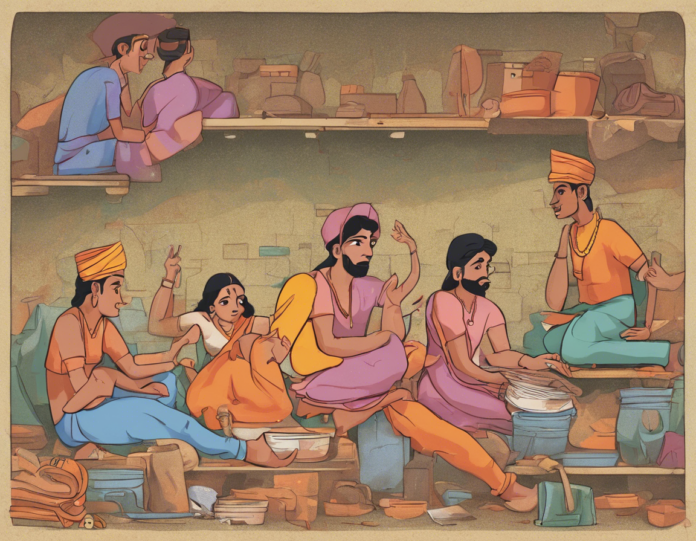Introduction:
Learning a new language can be an exciting and rewarding experience. One popular language spoken by over 600 million people worldwide is Hindi. If you are looking to delve into the realm of Hindi, one of the first phrases you might want to learn is “What are you doing?” This simple question allows you to engage in conversations, connect with native speakers, and expand your language skills. In this blog post, we will explore the various nuances and aspects of understanding and using the phrase “What are you doing?” in Hindi.
1. Basics of Hindi:
Before we delve into the specific phrase, let’s cover some basics of the Hindi language. Hindi is one of the official languages of India and is widely spoken in the northern and central parts of the country. It is an Indo-Aryan language with a rich history and literary tradition. Learning Hindi opens up opportunities for cultural exchange, travel, and personal growth.
2. Translation of “What are you doing?” in Hindi:
The phrase “What are you doing?” can be translated into Hindi as “तुम क्या कर रहे हो?” (pronounced as “tum kya kar rahe ho?”) when speaking to someone informally or in a casual setting. If you want to address someone formally or show respect, you can say “आप क्या कर रहे हैं?” (pronounced as “aap kya kar rahe hain?”).
3. Breaking Down the Sentence:
Let’s break down the Hindi sentence “तुम क्या कर रहे हो?” to understand its components:
- “तुम” (tum) – This is the informal pronoun for “you” used when addressing someone of the same age group or younger.
- “क्या” (kya) – This means “what” in Hindi.
- “कर रहे” (kar rahe) – This is the present continuous form of the verb “to do.”
- “हो” (ho) – This is the informal form of the verb “to be.”
By putting these elements together, you form the question “What are you doing?” in Hindi.
4. Common Responses:
When someone asks you “तुम क्या कर रहे हो?” in Hindi, you might respond with various activities or actions you are currently engaged in. Here are some common responses:
- “मैं पढ़ रहा हूँ” (main padh raha hoon) – I am reading.
- “मैं खाना खा रहा हूँ” (main khana kha raha hoon) – I am eating.
- “मैं सोने जा रहा हूँ” (main sone ja raha hoon) – I am going to sleep.
These responses allow you to practice using different verbs and sentence structures in Hindi conversation.
5. Additional Vocabulary:
Expanding your vocabulary is essential for mastering any language. Here are some additional words and phrases related to daily activities that you can use along with “तुम क्या कर रहे हो?” in Hindi:
- Reading – पढ़ना (padhna)
- Writing – लिखना (likhna)
- Cooking – पकाना (pakana)
- Watching TV – टीवी देखना (TV dekhna)
- Working – काम करना (kaam karna)
- Exercising – व्यायाम करना (vyaayaam karna)
By incorporating these words into your conversations, you can express yourself more fluently in Hindi.
6. Cultural Insights:
Understanding a language goes beyond just words; it involves immersing yourself in the culture and customs of native speakers. In Hindi-speaking cultures, it is common to use respectful language when addressing elders or strangers. Additionally, gestures and body language play a significant role in communication. By learning about the cultural nuances, you can deepen your connection with the language and its speakers.
Frequently Asked Questions (FAQs):
1. How do you say “What are you doing?” in formal Hindi?
- In formal Hindi, you can say “आप क्या कर रहे हैं?” (aap kya kar rahe hain?) when addressing someone with respect.
2. Can I use the phrase “तुम क्या कर रहे हो?” with strangers?
- It is advisable to use formal language when interacting with strangers or in professional settings. Opt for “आप क्या कर रहे हैं?” for a more respectful tone.
3. How can I practice conversations in Hindi with native speakers?
- You can join language exchange groups, online forums, or language classes to practice speaking with native Hindi speakers. Additionally, immersing yourself in Hindi movies, music, and books can help improve your language skills.
4. Are there different forms of “to do” in Hindi based on gender?
- Hindi verbs do not change based on gender. The verb “करना” (karna), which means “to do,” remains the same for both male and female speakers.
5. What are some common mistakes to avoid when using “तुम क्या कर रहे हो?”
- One common mistake is using the wrong verb form with the pronoun. Make sure to match the verb form with the appropriate pronoun (tum – कर रहे हो, aap – कर रहे हैं).
Conclusion:
Mastering the phrase “What are you doing?” in Hindi is a stepping stone towards fluency and cultural understanding. By grasping the nuances of this question, learning related vocabulary, and immersing yourself in the language, you can enhance your Hindi communication skills. Practice regularly, engage with native speakers, and continue exploring the richness of the Hindi language to broaden your linguistic horizons.









